CONCRETE DURABILITY AND AESTHETICS IMPROVEMENT IN CITIES
Philippe Ortega1, Laurent Bonafous, and Arunendu Ta2
1 CHRYSO Corporate, 19 Place de la Résistance, F-92446 Issy les Moulineaux Cedex
2 CHRYSO-SWC India, D-30/7, TTC Industrial area, M.I.D.C Turbhe, Navi Mumbai 400613, India
Abstract:
Concrete material development started a long time ago thanks to its plastic fresh properties and final mechanical strength. Soon, its limited cost and large availability enabled human activities and cities development beyond any other material in the past. Some years ago, concrete durability became a concern as well as its grey uniform surface lack of aesthetics. Over the last decades, while scientists started identifying more precisely the durability phenomena and parameters involved, the admixture chemistry industry helped to produce stronger and more durable concrete. By developing surface protection products like sealers, it was possible to reduce concrete skin permeability and sensitivity to chemical attacks and deposits while enhancing concrete colour intensity or shine, for example. Today, the industry evolves toward flexible and efficient solutions to support not only the durability of concrete but also its aesthetical integration into its surrounding. A large variety of shapes, textures and colours is becoming available at industrial scale for all concrete production processes. This presentation will report recent industrial progress.
INTRODUCTION
Concrete has long proven to be one of the most current and durable construction materials in the world. Thinking about concrete, we praise its ability to realize every kind of construction such as roads, bridges, tunnels, skyscrapers or more commonly residential houses. Three aspects can explain this success: the low cost, the everywhere availability of the raw materials and the capability to mould any kind of shape at ambient temperature. As a consequence, concrete has become nowadays so much natural part of our environment that we don’t take any more time to observe it. Unfortunately, when some people start to set their eyes on concrete, their opinion relates often to a lack of aesthetics. How many times have we heard complaints about impersonal, grey uniform concrete surfaces? It is clear that this aspect has been too long time neglected to the benefit of functional purposes. Today, however, sustainability awareness has been rising, which tends to better integrate concrete into its environment: in terms of durability, of course, but also in a more aesthetical way. In this approach, we will first analyse the most advanced practices to improve plain exposed concrete surfaces, considering especially raw materials, mix design and concreting process. Then we will see how surfaces can be further treated to the benefit of aesthetics, going through some innovative techniques which use multiple choices of colours and textures. Such enhancements making only sense if they withstand time, we will show case solutions able to provide a durable aesthetic advantage.
EXPOSED CONCRETE SURFACES
On an aesthetic point of view, exposed concrete is certainly one of the most challenging concrete types, as the quality of the final surface finish depends on a lot of parameters, starting from a precise selection of raw materials, then a proper mix design and finally an adequate concreting process.
RAW MATERIALS
Each type of raw material plays a role in concrete aesthetics. Aggregates first of all, fine and coarse, shall be selected carefully in terms of nature, colour, dimension and shape, according to placing conditions and final application. Basic specifications on current concrete become essential in case of exposed concrete, such as a limited fines content below 125 microns for coarse aggregates, a minimum sand cleanness, a low water absorption and a good resistance to alkali-silica reaction. As far as cement and supplementary cementious materials are concerned, their coloration influences especially the final concrete surface colour. The use of light coloured materials such as slag, limestone filler or metakaolin is recommended, whereas fly ash or blackish silica fumes should be avoided, as they can cause staining. Moreover, their colour regularity is a key point to guarantee a constant and uniform finished surface colour. Not to forget either that such materials have an impact on the final texture, as it influences the porosity of the surface. Regarding the batching water, every excess water or uncontrolled water addition should be prohibited, as it will impact the color intensity. The higher the W / C ratio, the lighter the concrete colour will appear (Figs 1a, 1b and 1c). The evaporation of the excess water leaves cavities on the surface looking like very fine pores, which disperse the light and then lighten the concrete.
Fig. 1
Finally, admixtures have an extended role in exposed concrete. While superplasticizers in a current structural concrete are mainly selected according to their water reduction capability, workability and strengths, superplasticizers used for exposed concrete are selected to improve further the workability retention while controlling the viscosity and the cohesion of the fresh concrete because these properties impact directly the final surface finish aspect. Viscosity modifying admixtures can improve directly the homogeneity, as they limit the risk of bleeding and segregation by thickening the paste. Efflorescence reducers or bughole reducers may also be sometime of special interest to mitigate mix design robustness issue. Micro and macrofibres (synthetic or natural fibres only for this application) will contribute to ensure a durable aesthetics of the surface by reducing early shrinkage cracks and by improving long term resistance against abrasion and shocks.
MIX DESIGN
A concrete mix design is generally prepared by taking into account the following factors: the environment, the concrete functions in the structure, the life span and the construction constraints. In case of exposed concrete, there are additional mix design principles that can be considered as fundamental rules for all other aesthetic concrete types. The paste (cement, supplementary cementitious materials, water, admixtures and air) is formulated first, as it is the visible, "exposed" concrete skin: whereas the role of the paste in a current concrete is to provide mainly a certain level of fluidity and viscosity, mechanical strengths and durability, in exposed concrete the paste properties influence also the uniformity of the tint, the porosity of the surface and consequently the texture aspect in terms of paste surface roughness. Basically, for exposed concrete, the paste volume should be rather increased in comparison with a standard structural concrete, in order to improve the final surface finish. The paste should be also designed in terms of workability retention, viscosity and homogeneity behaviour, three factors which are critical for exposed concrete and which depend basically on the total water content, the type of cement / supplementary cementitious materials, and the admixtures used. First, workability retention is essential to guarantee all the time the same quality of concrete placement, which influences the surface finish. Then, the viscosity should be set at a rather low level in order to ensure a proper and easy filling into the moulds (reinforcement cover, geometry of the moulds), and to allow entrapped air to escape quickly, therefore limiting bugholes. Finally, no lack of homogeneity should be allowed, neither significant bleeding nor segregation (some constituents separating out or settling down from the rest of the mix due to gravity or placing conditions). After the formulation of the paste comes the aggregate size distribution. For exposed concrete, in case of good quality aggregates, the experience collected in Europe shows good results with continuous curves, and gravel to sand ratios around 1.2 for vibrated concrete and 1.0 for self compacting concrete. In case of "difficult" aggregates, different solutions can be found according to the situation: Increase the paste volume in order to cover better angular aggregates, strictly control the humidity of aggregates with high absorption coefficient, adapt the admixtures (in case of sand with high fine content, clay particles, e.g.) or adapting the gravel to sand ratio using an experimental approach.
CONCRETING PROCESS
In addition to a proper mix design, a controlled and meticulous concreting process is essential to avoid surface defects, like the ones shown in Fig. 2.
Fig 2
 |
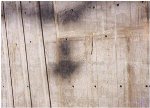 |
| Honey combing |
Black spots |
 |
| Colour variations |
First of all, a special care should be taken with the preparation of the moulds: they should keep exactly their shape, be perfectly clean and watertight. As far as reinforcement is concerned, it should be placed always after the release agent, and the spacers positioned carefully according to the concrete cover. The choice of the internal mould surface will be also selected carefully, depending on the required finish, the placing process and the number of use: steel is well adapted for example to smooth finish, whereas synthetic moulds (elastomers of polyurethane synthesis, silicone based polymers, e.g.) allow to reproduce specific textures like wood, natural stone… Another key point is the release agent. Its selection (from mineral based oils to vegetable based oils) will depend on the expected level of finish (regular or high), as well as health and safety criteria. In terms of application, it should always be applied in a uniform way on the surface of the mould, without excess in order to avoid side effects like fouling up, powdering, oxidation on the mould, or pinholes on the concrete surface. This is made possible by using proper spraying equipment, with adapted nozzles chosen accordingly to the viscosity of the release agent. Pressure, nozzle diameter and spacing, spraying height and speed are all driving factors that control finally the homogeneity of covering. When comes the time of placing, some precautions have to be taken necessarily in case of exposed concrete, like a good planning of the placing sequences in order to avoid interruptions and a reinforced quality control of the concrete (proscribe any water addition on site). Working with clean buckets, limiting fall heights, avoiding too long waiting times especially in hot weather conditions are among the best practices to be followed. Regarding the consolidation process, it is imperative to adapt the vibration to the mould and the concrete plasticity, and, in case of external vibration, to check the rigidity of the mould and the support.
As far as demoulding is concerned, it is important to adapt its time to the maturity of the concrete, as the colour of the surface is greatly influenced by the maturity level. After demoulding, it is highly recommended to beware of surface conditioning and protect accordingly the concrete elements against rain, wind or possible external projections. Surface dessication induced pattern is a common issue while curing agents are today widely available. These are all best practices that have to be respected when the quality of exposed concrete surfaces is at stake.
COLOURS AND TEXTURES
Apart from natural exposed concrete surfaces, it is nowadays possible to apply multiple techniques in order to bring concrete up to additional aesthetic dimensions, through different colours, shapes or textures.
COLOURS
Coming as powders, granules or slurries, colouring agents have been successfully used in the last decades for colouring concrete in mass. Usually based on iron oxides for the most common colours yellow, brown, red or black, they are able to withstand cementitious alkaline medium, as well as light and weathering. Quality and durable coloured concrete however will require not only a proper pigment with high colouring ability, but also a perfect consistency of cementitious materials, fine aggregates and total water.
TEXTURES
In addition to the colour, a concrete surface can get a particular texture: rough, smooth, with patterns either sunken or in relief, in horizontal as well as in vertical way. It can be achieved by mechanical actions (bush-hammering, shot or sand blasting, polishing), as well as chemical or stamped treatments, either at the time of placing, or on fresh / hardened concrete state. We will deliberately focus hereafter on a few technologies that have recently seen some noticeable evolutions.
FROM EXPOSED AGGREGATE CONCRETE…
Exposed aggregate concrete is a well-known chemical treatment obtained by applying a particular retarder (so called "surface retarder") on the concrete surface, intended to delay superficially the set, exposing the aggregates after the surface has been washed off (Fig. 3). The retardation can occur on the free surface of a fresh concrete ("positive" way) or on the inside face of moulds ("negative" way).
Fig. 3 Positive exposed aggregate concrete being washed
From an aesthetic point of view, the texture of an exposed aggregate concrete can adapt perfectly to the landscape, as it enhances the local aggregates becoming exposed. Also, it is a very versatile material, which can appear very rural when associated for example with paving stones, or very modern looking when associated with granite or steel (Fig. 4) . It is thus no coincidence that this concrete has so well developed in European urban environments.
Fig. 4 Different textures of exposed aggregate concrete
…TO BRUSHED CONCRETE
Recently, a breakthrough technology has reinvented positive exposed aggregate concrete: it basically replaces the washing-off process by a simple brushing of the surface (Fig. 5). As a result of the CHRYSO company Research and Development and patent pending, the so called CHRYSO®Deco Brush products have become the first brushable surface retarders on the market. In countries where sustainable construction is more and more present, this innovative “brushed concrete” concept allows to preserve storm-water drains and wastewater sewers from being clogged with cement paste while reducing drastically the water consumption for the overall application process. Last but not least, the brushing residue is inert and can be either used during the next pour or considered as a traditional concrete waste.
Fig. 5 Dry washing process of brushed concrete
This technique (Fig. 7) can be described as follows: a stencilled membrane is used to reproduce the desired pattern on the top of a concrete designed and placed like for regular exposed aggregate application. The membrane is unrolled and pressed down onto the surface before spraying the surface retarder uniformly. It will consequently cover the concrete surface according to the stencil membrane openings. The washing out 24 hours later after removal of the membrane is done traditionally with a high pressure jet.
Fig. 6 Decorative engraved concrete in urban environment
In a word, this new aesthetic solution allows customisation of new urban developments into unique areas with patterned concrete finishes and effects.
Fig 7
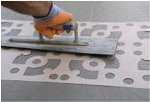 |
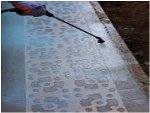 |
| Membrane application |
Surface retarder application |
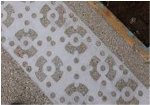 |
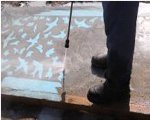 |
| Final aspect |
Washing |
STAMPED CONCRETE
We could not conclude our statement without mentioning stamped concrete, as it spreads more and more in India. Already very popular in the USA and in some European countries, stamped concrete is a good example of one of the most advanced aesthetic concrete evolutions, due to its high versatility to imitate any type of texture, including colour, from wood boards to natural stone aspects. The concrete surface is basically coloured by spreading a so called "surface hardener" (a powder containing colouring agents, fine aggregates and cementitious materials) on top of the fresh concrete, and then stamped with the use of specific synthetic moulds during concrete set (Fig. 8).
Fig. 9 Stamping and engraving of an Indian pattern
Combining this method with the engraving concept described before, it is possible to reach very nice effects: the concrete specimen shown hereafter, realized in laboratory scale, is made of a red coloured base concrete, on top of which some white surface hardener has been applied through a fine sieve reproducing typical Indian Rangoli patterns (Fig. 9).
AESTHETICS AND DURABILITY
Although concrete is one of the most durable construction materials, it has to resist against many types of attacks, especially in outdoors conditions: water, salts, pollution, stains, micro-organisms…It is therefore all the more important to protect aesthetic concrete, in order to keep its aspect durable. Concrete is naturally a porous material. It is the porosity that will interact with the external environment. Aggressive agents will be able to penetrate in the concrete and be responsible for disorders such as scaling, physical alteration or even chemical destruction. In order to prevent these pathologies, the priority is to limit as much as possible the penetration of water inside the concrete, while still enabling gas exchanges between the concrete surface and its environment. Along with the development of aesthetic concrete, the admixture chemistry industry has developed different kind of protection products, able to seal the surface. They can consequently limit the penetration of stains on the surface and facilitate their cleaning, limit the wear of the surface, and even bring more or less shine and colour intensity. These are typically acrylic polymers, polyurethanes, waxes, silanes / siloxanes or organic salts, which can be classified in three main categories according to their interaction mode with the surface: film forming products, impregnation products and liquid floor hardeners. The selection of a product will depend on the type of constraint (shopping malls, individual houses, offices, e.g.) and the aspect sought, involving consequently these products in the final concrete aesthetics, as shown in Fig. 10.
 |
Fig.10 Sealers with glossy and mat finish (resp. CHRYSO®Finisol Perle, on the left, and CHRYSO®Finisols Mat on the right)
CONCLUSION
Concrete has been experiencing great evolutions: from pre-stressed to self-compacting or ultra high strengths technologies, just to mention a few. Nowadays, the growing sustainability awareness in most countries is pushing designers and manufacturers towards a better integration of concrete in its environment, also from an aesthetic point of view. Thanks to newly developed concrete products and technologies, as we could see from the few examples described in this paper, like brushed concrete, or decorative engraved concrete, the concrete industry has now all the flexibility to think out of the box…a box no longer always grey, but multiform and colourful.